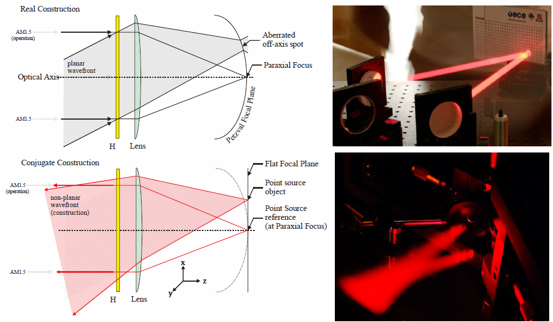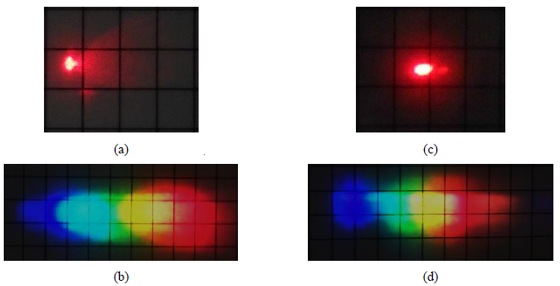|
图7.真实的全息记录(左上),用于补偿彗差并将接收器(能隙)定位在平坦表面上的共轭结构(左下)。
近轴焦点处的参考点光源由透镜转换成平面波前。相反,物点光源被透镜转换成有像差的准平面波前。通过在透镜的平面上记录具有准平面波前的光栅来校正该效应。
通过在平坦表面上使用期望的点源对象光束,来调整接收器的位置,如图7的左下几何结构所示。
图8.在左边,采用真实结构(平面光栅)记录的光栅重建,分别对应于(a)单色光(633nm的HeNe)和(b)白光(氙弧太阳模拟器)。在右侧,采用共轭结构(补偿光栅)记录的光栅重建,分别对应于(c)单色光和(d)白光。
图8(a)和(c)的比较显示出彗差的共轭结构补偿,将光引向更紧密的焦点。对于单色和白光重建可以看到类似的结果。
4. 结论
在本文中,讨论了光谱分裂作为用于多结PV系统的串联电池的替代。提出了频谱转换效率(SCE)、整体系统效率、滤波器加权重叠(O)和对最佳能隙(IoBB)的改进,并将其定义为光谱分裂系统的评估度量。描述了全息光栅-透镜几何结构,并已经给出模拟和实验结果。对于在可见光范围(<0.9μm)中具有更多能隙的系统,IoBB显示较大值。
光栅-透镜几何结构的离轴衍射角导致彗差和显着的系统损耗。提出并演示了使用共轭记录几何来补偿这种损耗的方法。
正在进行的工作包括使用系统度量结合已建立的用于全息光学元件中的最小化像差技术来增加总体光电转换效率。
5. 致谢
作者想要感谢NSF / DOE ERC合作协议号EEC-1041895、NSF批准号0925085、亚利桑那州TRIF(WEES)项目和研究公司的支持。
参考文献
[1] T. O. M. Tiedje, E. L. I. Yablonovitch, G. D. G. D. Cody, and B. G. B. G. B. G. Brooks, “Limiting efficiency of silicon solar cells,” IEEE Transactions on Electron Devices 31(5), 711–716 (1984) [doi:10.1109/TED.1984.21594].
[2] A. Barnett, D. Kirkpatrick, C. Honsberg, D. Moore, M. Wanlass, K. Emery, R. Schwartz, D. Carlson, S. Bowden, et al., “Very high efficiency solar cell modules,” Progress in Photovoltaics: Research and Applications 17(1), 75–83 (2009) [doi:10.1002/pip.852].
[3] M. A. Green, K. Emery, Y. Hishikawa, W. Warta, and E. D. Dunlop, “Solar cell efficiency tables (version 42),” Progress in Photovoltaics: Research and Applications 21(5), 827–837 (2013) [doi:10.1002/pip.2404].
[4] E. Hecht, Optics 4th edition, in Optics 4th edition by Eugene Hecht Reading, MA: … (2001).
[5] A. L. Gray, M. Stan, T. Varghese, A. Korostyshevsky, J. Doman, A. Sandoval, J. Hills, C. Griego, M. Turner, et al., “Multi-terminal dual junction InGaP<inf>2</inf>/GaAs solar cells for hybrid system,” in 2008 33rd IEEE Photovolatic Specialists Conference, pp. 1–4, IEEE (2008) [doi:10.1109/PVSC.2008.4922575].
[6] J. D. McCambridge, M. A. Steiner, B. L. Unger, K. A. Emery, E. L. Christensen, M. W. Wanlass, A. L. Gray, L. Takacs, R. Buelow, et al., “Compact spectrum splitting photovoltaic module with high efficiency,” Progress in Photovoltaics: Research and Applications 19(3), 352–360 (2011) [doi:10.1002/pip.1030].
[7] D. Zhang, M. Gordon, J. M. Russo, S. Vorndran, M. Escarra, H. Atwater, and R. K. Kostuk, “Reflection hologram solar spectrum-splitting filters,” K. VanSant and A. P. Plesniak, Eds., 846807–846807–10 (2012) [doi:10.1117/12.929187].
[8] B. Mitchell, G. Peharz, G. Siefer, M. Peters, T. Gandy, J. C. Goldschmidt, J. Benick, S. W. Glunz, A. W. Bett, et al., “Four-junction spectral beam-splitting photovoltaic receiver with high optical efficiency,” Progress in Photovoltaics: Research and Applications 19(1), 61–72 (2011) [doi:10.1002/pip.988].
[9] E. D. Aspnes, J. E. Castillo, R. D. Courreges, P. S. Hauser, G. Rosenberg, and J. M. Russo, “Volume Hologram Replicator for Transmission Type Gratings,” U.S. Patent No. Application US 2013/0120815 A1, in WO Patent …, United States (2013).
[10] R. K. Kostuk, J. Castillo, J. M. Russo, and G. Rosenberg, “Spectral-shifting and holographic planar concentrators for use with photovoltaic solar cells,” in Proceedings of SPIE 6649, M. Symko-Davies, J. Guo, B. von Roedern, D. R. Myers, and A. E. Delahoy, Eds., p. 66490I–66490I–8, San Diego, CA (2007) [doi:10.1117/12.736542].
[11] D. Jurbergs, F. Bruder, F. Deuber, T. Fäcke, R. Hagen, T. Rölle, M. Weiser, A. Volkov, B. M. Llc, et al., “New recording materials for the holographic industry,” 1–10 (2009) [doi:10.1117/12.809579].
[12] M. Gordon, D. Zhang, S. Vorndran, J. M. Russo, C. K. Luscombe, S. E. Shaheen, and R. K. Kostuk, “Planar holographic spectrum-splitting PV module design,” High and Low Concentrator Systems for Solar Electric Applications VII 8468(520), K. VanSant and A. P. Plesniak, Eds., 846808–846808–9 (2012) [doi:10.1117/12.929387].
[13] J. Zhao, A. Wang, M. A. Green, and F. Ferrazza, “19.8% efficient ‘honeycomb’ textured multicrystalline and 24.4% monocrystalline silicon solar cells,” Applied Physics Letters 73(14), 1991 (1998) [doi:10.1063/1.122345].
[14] G. J. Bauhuis, J. J. Schermer, P. Mulder, M. M. A. J. Voncken, and P. K. Larsen, “Thin film GaAs solar cells with increased quantum efficiency due to light reflection,” Solar Energy Materials and Solar Cells 83(1), 81–90 (2004) [doi:10.1016/j.solmat.2003.11.030].
[15] K. Winick, “Designing efficient aberration-free holographic lenses in the presence of a construction-reconstruction wavelength shift,” Journal of the Optical Society of America 72(1), 143 (1982) [doi:10.1364/JOSA.72.000143].
文章来源:Grating-Over-Lens Concentrating Photovoltaic Spectrum SplittingSystems with Volume Holographic Optical Elements
|



